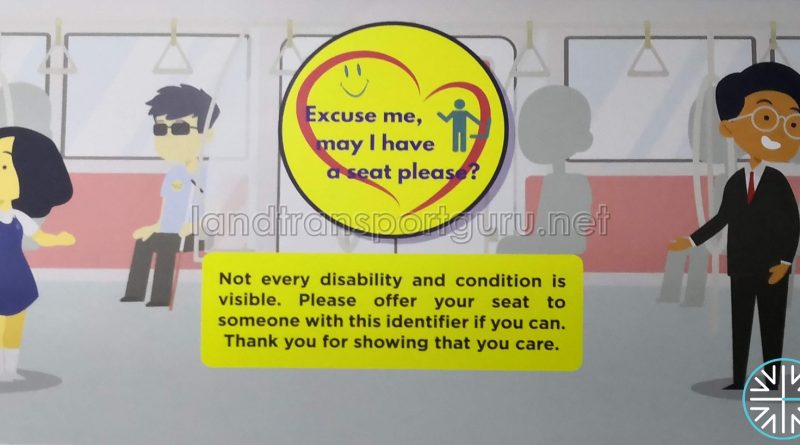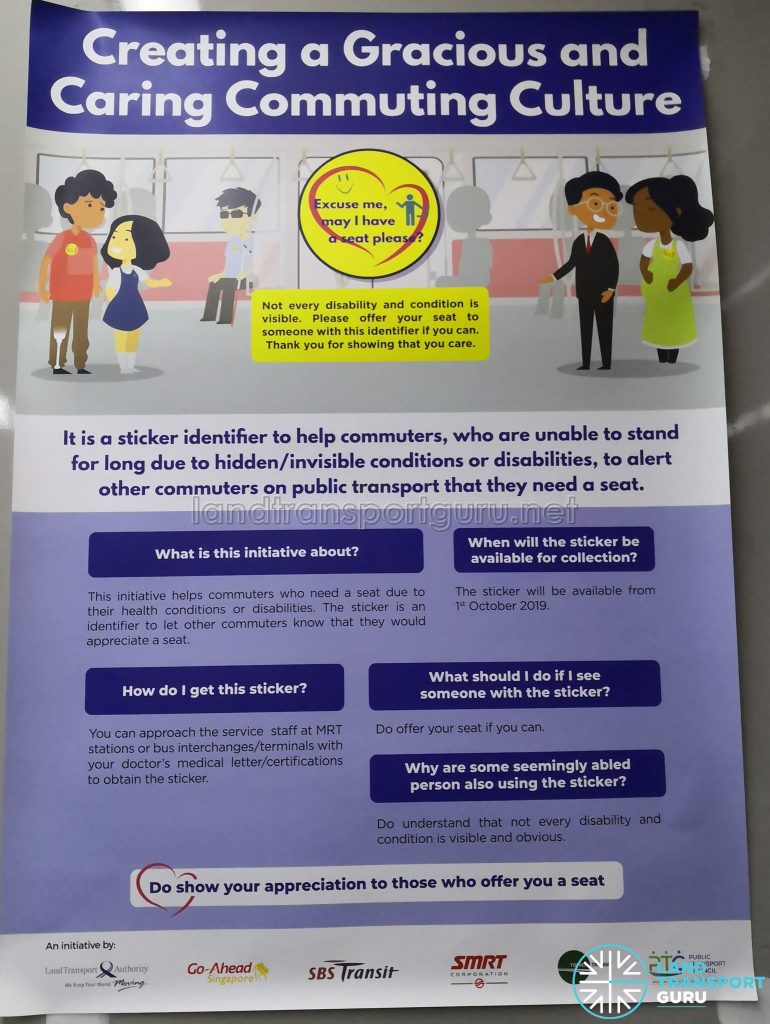Excuse me, may I have a seat please?
Starting from 1 October 2019, commuters who need a seat on public transport due to health conditions or disabilities, which may prevent them from standing for prolonged periods, can collect and display an identification sticker to alert fellow commuters that they require a seat.
With a medical certificates or doctors’ letters to support their request (if comfortable), commuters may collect the sticker from 1 October 2019 progressively at the following places:
- Passenger Information Centre or Passenger Information Office at any MRT Station
- Service Staff at MRT Stations
- Passenger Information Centre or Passenger Information Office at any Bus Interchange / Terminal
- Service Staff at Bus Interchanges / Terminal
- All Transitlink Ticket Offices
Not all health conditions and disabilities are always visible. Commuters are encouraged to offer a seat to people with the yellow “Excuse me, may I have a seat please?” sticker.
These stickers are part of an initiative to make public transport more inclusive for commuters through creating a gracious and caring commuting culture.
- What is this initiative about?This initiative helps commuters who need a seat due to their health conditions or disabilities. The sticker is an identifier to let other commuters know that they would appreciate a seat
- How do I get this sticker?You can approach the service staff at MRT stations or bus interchanges/terminals with your doctor’s medical letter/certifications to obtain the sticker.
- When will the sticker be available for collection?The sticker will be available from 1st October 2019
- What should I do if I see someone with the sticker?Do offer your seat if you can!
- Why are some seemingly abled person also using the sticker?Do understand that not every disability and condition is visible and obvious.
Transport for All
Efforts to build a more inclusive land transport system were outlined in the COS 2019 Debate and the Land Transport Master Plan 2040. Apart from fostering a caring and gracious commuting culture, authorities are implementing wide-ranging infrastructural enhancements across the transport network.
Other projects in the pipeline include:
- Priority cabin trial for pregnant women, seniors, wheelchair users and parents with young children in strollers on one MRT line in 2020
- Priority queues at all MRT stations (by end 2019) and all bus interchanges (by 2021)
- Heart Zones initiative expanded to all MRT stations and bus interchanges
- Removing all barriers for wheelchair users in their commute
- More lifts installed at pedestrian overhead bridges by 2022, including 28 that are near hospitals and polyclinics.
- All public buses and bus stops to be wheelchair-accessible by 2020
- All public buses with information screens displaying upcoming bus stops and rail connections, with audio announcements for the visually-impaired
- Larger fonts and Braille for signs at all major public transport facilities
- Stroller restraint systems for all buses by end-2019
- Seats at existing bus stops retrofitted with armrests; first batch of 2,300 bus stops by 2021
- More covered linkways to connect public housing estates to bus stops and train stations, including benches for people to stop and rest
- Road safety installations “Silver Zones” at 50 mature estates by 2023 – narrower roads, speed humps and two-stage pedestrian crossings
- Trial speed limit reduction in selected “silver zones” from 40km/h to 30km/h
- Red-amber-green arrows at about 1,000 junctions by 2023 – eventual goal beyond 2030 to remove all discretionary right turns at junctions
Similar priority seat stickers are in use across the London transport network and on the Tyne and Wear Metro in North East England. As opposed to the Land Transport Authority’s approach, Transport for London’s scheme is entirely self-selecting and does not require commuters to produce medical history or supporting evidence from a doctor.
External Links & References:
- Please offer me a seat – Transport for London
- LTA Pilots New Initiative to Help Commuters with Invisible Medical Conditions – LTA
Back to Bus Articles



Similar thing particularly for pregnant women has been in existence for a few years in Taipei too, but I have never seen anyone actually wearing it. I think people are too shy to carry it because it draws attention and looks like you demand people to offer you a seat.
Having just a sticker does not seemed practical.
May be in the form of a badge or card form could be more practical where one can hang it from the neck or in wallet.